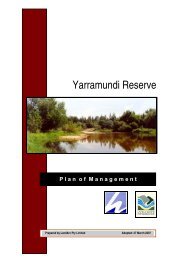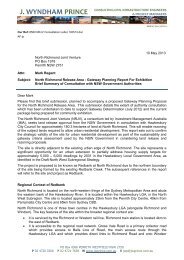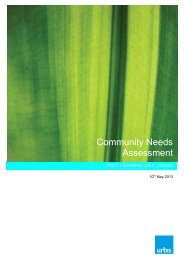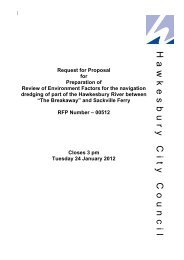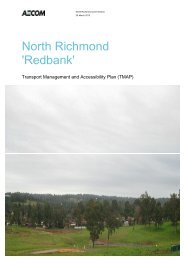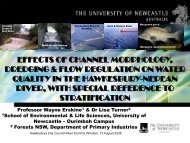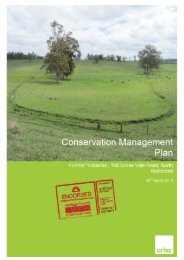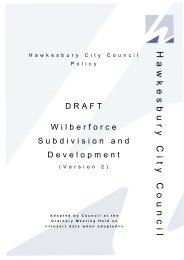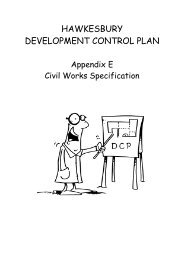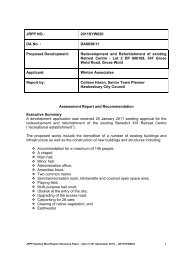Attachment 1 to Item 53 - Roadside Vegetation Management Plan
Attachment 1 to Item 53 - Roadside Vegetation Management Plan
Attachment 1 to Item 53 - Roadside Vegetation Management Plan
You also want an ePaper? Increase the reach of your titles
YUMPU automatically turns print PDFs into web optimized ePapers that Google loves.
H AW K E S B U R Y C IT Y C O U N C IL R O AD S ID E V E G E T AT IO N M AN AG E M E N T P L AN<br />
o anticipated tree growth rates and mature heights (<strong>to</strong> minimise pruning); and<br />
o rehabilitation techniques.<br />
• Where existing indigenous vegetation is disturbed during works, ensure that contrac<strong>to</strong>rs<br />
and staff rehabilitate works areas <strong>to</strong> (as close as practical) the condition prior <strong>to</strong><br />
commencement of works. Use species of robust indigenous ground cover species that are<br />
naturally present in vegetation communities in works areas rather than exotic grass<br />
species. Provide replacement indigenous plants naturally present in vegetation<br />
communities in works areas <strong>to</strong> compensate for any trees removed during installation<br />
works. Moni<strong>to</strong>r site rehabilitation and vegetation re-establishment, control weeds and<br />
replace any lost planted s<strong>to</strong>ck for 12 months after completion of works, as part of the<br />
contract; and<br />
• During trenching works, ensure that contrac<strong>to</strong>rs salvage, s<strong>to</strong>re and respread <strong>to</strong>psoil <strong>to</strong><br />
match the original soil profile. Also, ensure that works areas are stabilised with<br />
revegetation using indigenous species that are naturally present in vegetation communities<br />
in works areas or alternatively a sterile cereal rye grass. Rather than severely pruning<br />
trees (e.g. cut <strong>to</strong> near ground level) growing directly under any power lines, encourage<br />
removal of the tree and replacement with indigenous species naturally present in<br />
vegetation communities in works areas that do not require such pruning.<br />
6.13 LANDUSE (AGRICULTURAL USE – TRAVELLING STOCK ROUTES)<br />
As grazing by s<strong>to</strong>ck can have negative effects on biodiversity and contribute <strong>to</strong> erosion or change the<br />
nutrient status of soil or local hydrology (see Section 3.14), the issuing of s<strong>to</strong>ck permits must be<br />
carefully considered. The following actions detail how roadside environments should be managed for<br />
grazing.<br />
• Develop a roadside grazing policy specifically outlining the conditions under which<br />
roadside grazing will be approved and the issues of consideration when determining<br />
approval. Issues of consideration may include:<br />
o the sensitivity of vegetation or environment in the proposed grazing area and along<br />
the route;<br />
o the nature of any weeds in the area and the potential for lives<strong>to</strong>ck <strong>to</strong> contribute <strong>to</strong><br />
weed spread; and<br />
o driver safety.<br />
• Require that all people who have been issued with a s<strong>to</strong>ck permit <strong>to</strong> display their s<strong>to</strong>ck<br />
permit on any nearby fencing within the area that is being grazed;<br />
• Only permit roadside grazing in low conservation priority roadsides unless a Fire<br />
<strong>Management</strong> <strong>Plan</strong> or Weed Control <strong>Plan</strong> allows for limited grazing on medium<br />
conservation priority roadsides, avoiding:<br />
o areas that allow access <strong>to</strong> natural waterways and drainage lines;<br />
o areas near sensitive areas such as wetlands and national parks;<br />
o areas where regeneration of native vegetation is occurring; and<br />
o areas comprising EECs.<br />
• Only permit grazing where soil stability is sound. Avoid:<br />
o areas lacking a stable vegetation cover;<br />
o areas where soils are wet;<br />
o areas which contain steep surfaces such as road batters; and<br />
o areas highly exposed <strong>to</strong> wind and water run off.<br />
• Restrict grazing between September - Oc<strong>to</strong>ber and late January so that native grasses and<br />
other plants can flower and set seed;<br />
© E C O L O G I C AL AU S T R AL I A P T Y L T D<br />
58



